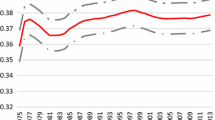Abstract
Previous time series analyses on the effect of business cycles on population health suffered from potential aggregation and omitted variable biases stemming from the aggregation of the high frequency data commonly used to measure business cycles (such as quarterly GDP per capita or monthly unemployment rate) into low frequency data (such as annual GDP per capita or unemployment rate). In order to deal with this temporal aggregation issue, this study applies the Mixed Frequency Vector Auto-regressive (MF-VAR) model to investigate the causal relationship between health progress and economic growth during the period of 1948:Q1–2016:Q4 in the US for the first time. Our results based on the forecast error variance decomposition suggest that the MF-VAR model achieves higher explanatory power than the conventional VAR model with single frequency data. Despite a bi-directional causation between health progress and economic growth being identified using the mixed frequency Granger causality tests, the impulse-response analyses under the MF-VAR model found a changing correlation between health progress and economic growth across the four quarters within each 1-year time period. These findings effectively reconcile the controversial results from previous time series analyses on the effect of business cycles on population health.


Similar content being viewed by others
References
Barro, R.J.: Health and economic growth. Ann. Econ. Finance Soc. AEF 14(2), 329–366 (2013)
Baumbach, A., Gulis, G.: Impact of financial crisis on selected health outcomes in European. Eur. J. Pub. Health 24(3), 399–403 (2014)
Brenner, M.H.: Mortality and the national economy. Lancet 314, 568–573 (1979)
Brenner, M.H.: Commentary: economic growth is the basis of mortality rate decline in the 20th century-experience of the United States 1901–2000. Int. J. Epidemiol. 34, 1214–1221 (2005)
Bruckner, T.A., Noymer, A., Catalano, R.: Life expectancy during the Great Depression in eleven European countries. Popul. Dev. Rev. 39(1), 57–74 (2013)
Catalano, R., Bruckner, T.: Clear and simple: no association between the Great recession and period life expectancy at birth in the USA. Int. J. Epidemiol. 45(5), 1681–1686 (2016)
Chantrill, C.: US Government Spending: History, Facts and Charts of Spending, Taxes and Debt, Federal, State and Local, 2017 edition. usgovernmentspending.com, Seattle (2017)
Chen, W.Y.: Health progress and economic growth in the United States: the continuous wavelet analysis. Empir. Econ. 50(3), 831–855 (2016)
Ferreira, F., Schady, N.: Aggregate economic shocks, child schooling, and child health. World Bank Res. Obs. 24, 147–181 (2009)
Ghysels, E.: Macroeconomics and the reality of mixed frequency data. J. Econom. 193, 294–314 (2016)
Ghysels, E., Hill, J.B., Motegi, K.: Testing for Granger causality with mixed frequency data. J. Econom. 192, 207–230 (2016)
Gonçalves, S., Kilian, L.: Bootstrapping autoregressions with conditional hetero-skedasticity of unknown form. J. Econom. 123(1), 89–120 (2004)
Gonzalez, F., Quast, T.: Mortality and business cycles by level of development: evidence from Mexico. Soc. Sci. Med. 71, 2066–2073 (2010)
Grossman, M.: On the concept of health capital and the demand for health. J. Polit. Econ. 80(2), 223–255 (1972)
Janko, Z., Emery, J.C.H., Guenette, P.: The short-run and long-run relationships between mortality and the business cycle in Canada. Econ. Res. Int. 2013, Article ID 409738 (2013). https://doi.org/10.1155/2013/409738
Kasl, S.V.: Mortality and the business cycle: some questions about research strategies when utilizing macro-social and ecological data. Am. J. Public Health 69, 784–788 (1979)
Laporte, A.: Do economic cycles have a permanent effect on population health? Revising the Brenner hypothesis. Health Econ. 13(8), 767–779 (2004)
Morgado, S.M.A.: Does health promote economic growth? Portuguese case study: from dictatorship to full democracy. Eur. J. Health Econ. 15, 591–598 (2014)
Motegia, K., Sadahirob, A.: Sluggish private investment in Japan’s lost decade: mixed frequency vector autoregression approach. N. Am. J. Econ. Finance 43, 118–128 (2018)
Regidor, E., Barrio, G., Bravo, M.J., de la Fuente, L.: Has health in Spain been declining since the economic crisis? J. Epidemiol. Community Health 68(3), 280–282 (2014)
Sevensson, M., Krüger, N.A.: Mortality and economic fluctuations: evidence from wavelet analysis for Sweden 1800-2000. J. Popul. Econ. 25, 1215–1235 (2012)
Silvestrini, A., Veredas, D.: Temporal aggregation of univariate and multivariate time series models: a survey. J. Econ. Surv. 22, 458–497 (2008)
Swift, R.: The relationship between health and GDP in OECD countries in the very long run. Health Econ. 20(3), 306–322 (2011)
Tapia Granado, J.A.: Economic growth and health progress in England and Wales: 160 years of a changing relation. Soc. Sci. Med. 74, 688–695 (2012)
Tapia Granados, J.A.: Macroeconomic fluctuations and mortality in postwar Japan. Demography 45(2), 323–343 (2008)
Tapia Granados, J.A., Diez Roux, A.V.: Life and death during the Great Depression. Proc. Natl. Acad. Sci. 106, 17290–17295 (2009)
Tapia Granados, J.A., Ionides, E.L.: The reversal of the relation between economic growth and health progress: Sweden in the 19th and 20th centuries. J. Health Econ. 27(3), 544–563 (2008)
Tapia Granados, J.A., Rodriguez, J.M.: Health, economic crisis, and austerity: a comparison of Greece, Finland and Iceland. Health Policy 119, 941–953 (2015)
Weil, D.N.: Economic Growth. Pearson, Boston (2005)
Acknowledgements
We would like to thank Professor Kaiji Motegi (from Kobe University, Japan) sharing his Matlab codes for us to estimate the LF-VAR and MF-VAR models. The final proof-reading of the study by Lisa Brutcher (at Washington State University, USA) is deeply acknowledged. All errors are mine.
Author information
Authors and Affiliations
Corresponding author
Ethics declarations
Conflict of interest
We declare that we have no competing interests.
Additional information
Publisher’s Note
Springer Nature remains neutral with regard to jurisdictional claims in published maps and institutional affiliations.
Electronic supplementary material
Below is the link to the electronic supplementary material.
Rights and permissions
About this article
Cite this article
Liu, YH., Chang, WS. & Chen, WY. Health progress and economic growth in the United States: the mixed frequency VAR analyses. Qual Quant 53, 1895–1911 (2019). https://doi.org/10.1007/s11135-019-00847-z
Published:
Issue Date:
DOI: https://doi.org/10.1007/s11135-019-00847-z




